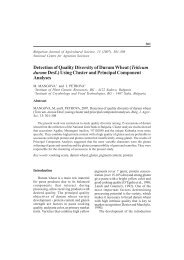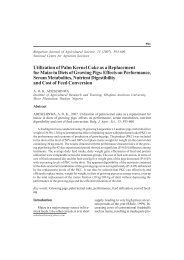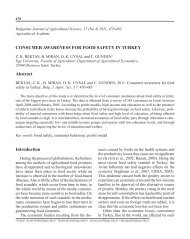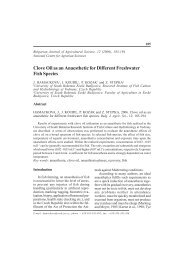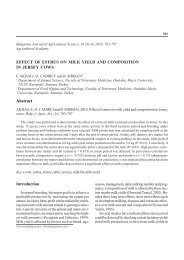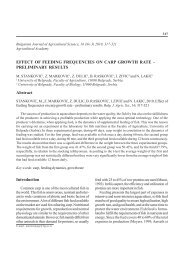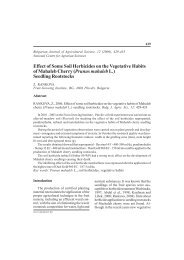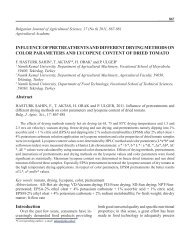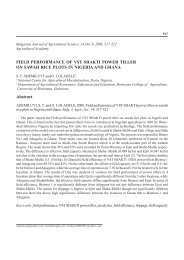parasitoid assemblages isolated from externally feeding ...
parasitoid assemblages isolated from externally feeding ...
parasitoid assemblages isolated from externally feeding ...
You also want an ePaper? Increase the reach of your titles
YUMPU automatically turns print PDFs into web optimized ePapers that Google loves.
Parasitoid Assemblages Isolated From Externally Feeding Lepidopterans and Codling Moth... 679and Bactromyia aurulenta (Meigen, 1824) as <strong>parasitoid</strong>sof Y. mallinellus in Bulgaria. Hence, the list ofinsects known to parasitize Y. mallinellus in Bulgariaincludes 27 species.The oligophagous ichneuomonid wasp Scirtetesrobustus (Woldstedt), which develops in noctuid larvae,was one of the first <strong>parasitoid</strong>s to appear in theyoung apple orchard. One infested larva of Orthosiacerasi (Fabricius, 1775) was found on 3.05.2007, andS. robustus emerged on 17.03.2008.The species which first parasitized the codlingmoth were Liotryphon caudatus (Ratzeburg 1848) andAscogaster quadridentata (Wesmael, 1835). The firstfound <strong>parasitoid</strong> in young orchard D. cavus emerged ofcodling moth larvae on 27.07.2009.In total, five <strong>parasitoid</strong>s were <strong>isolated</strong> <strong>from</strong> codlingmoth larvae, collected in the young apple orchard.Two of them belong to family Ychneumonidae, oneto Braconidae, and one to Pteromalidae (Table 1). A.quadridentata was the only egg-larval <strong>parasitoid</strong>. Thelist of <strong>parasitoid</strong> species <strong>isolated</strong> <strong>from</strong> codling mothdeveloping in the fruits of aged untreated apple treesin the vicinity of the investigated experimental orchardcomprised two more representatives of familyYchneumonidae – the solitary larval endo<strong>parasitoid</strong>Pristomerus vulnerator (Panzer, 1799) (Cremastinae)and the solitary pupal endo<strong>parasitoid</strong> Pimpla turionellae(Linnaeus, 1758) (Pimplinae), as well as one morespecies <strong>from</strong> family Braconidae – Bassus (Microdus)rufipes (Nees, 1812). The list did not include Pimplaarcadica (Kasparyan, 1973) which was <strong>isolated</strong> <strong>from</strong>codling moth in the young orchard. According to Kolarov(1997), P. arcadica is very rare and was foundby the author in April only in Strandzha mountain inour country. The species was first described <strong>from</strong> TheCrimea by Kaparjan (1973). Consequently, it was reportedfor Sweden (Yu et al., 2005), Norway (Hansenet al., 2010) and the North-East Anatolian Region ofTurkey (Coruh, 2010). Obviously, P. arcadica Kas.develops two generations per year - in Turkey it wascollected in June and August (Coruh, 2010), while ourspecimen emerged on 12.08.2009.The <strong>parasitoid</strong> tachinid fly Elodia morio (Fallen,1820) emerged <strong>from</strong> codling moth larvae collectedwith bands <strong>from</strong> both the young and the aged appletrees. The <strong>parasitoid</strong> was registered for the first timein 2008, four years after planting of the orchard. Tenwasps of the family Ichneumonidae were listed as larvaland pupal <strong>parasitoid</strong>s of C. pomonella in Bulgariaby Atanassov (1986) and eleven braconids were listedby Balevski (2009). Aleiodes bicolor (Spinola, 1808)and Microgaster meridiana (Haliday, 1834) were reportedas <strong>parasitoid</strong>s of codling moth by Peeva et al.(2010) and P. arcadica (Kasparyan, 1973) by Kolarov(1997). We also <strong>isolated</strong> Exorista fasciata (Fallen,1820) <strong>from</strong> codling moth larvae collected in an organicorchard in Plovdiv region. This is a new report of host- <strong>parasitoid</strong> relationship, contributing to the extensivehost list compiled by Hubenov (1985, 2001). With theaddition of Elodia morio (Fallen, 1820) first announcedby Trenchev (1980), the Bulgarian faunistic list of<strong>parasitoid</strong>s of the codling moth now comprises 26 parasoitoids.So, 19.2% of all <strong>parasitoid</strong> species known tooccur in our country were attracted immediately afterthe appearance of their host in the young apple orchard.According to Lloyd (by Laurence et al., 2005), thereare over 100 insect species parasitizing the codlingmoth worldwide.The rates of parasitism on codling moth establishedin our study and presented in Table 2 were very low.There are similar reports of considerably low rates ofparasitism on C. pomonella. For example, Monteiro etal. (2010) reported mean rates of infestation of 3.7%,2.3% and 0.8% in organic and conventional with andwithout mating disraption in France. The authors didnot find parasitized diapausing codling moth larvae in79% and 83.6% of the observed apple orchards.In the period 1994 – 1995, the reported mean rateof infestation of the codling moth in Switzerland (LaTable 2Relative density of codling moth, <strong>externally</strong> leavinglepidopteran larvae and mean rate of parasitismYearsMean numberof diapausingcodling mothlarvae/bandRate ofparasitsm,%Relativedensity oflarvae on100 organsRate ofparasitism,%2005 0 0 6.7 02006 0 0 8.8 32007 3.1 0 16.7 52008 11.9 5.3 13.9 8.92009 7.8 0.9 8.6 9




